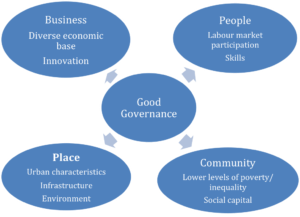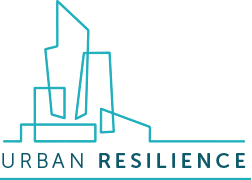The ability of local and regional economies to withstand and recover from economic shocks came under intense scrutiny during the financial crisis of 2008/2009. One study, led by Cardiff University, compared levels of regional economic resilience across the whole of the EU plus Norway, Switzerland and Lichtenstein. This found that there are five key features to a resilient economy.

Resilient economies are based on:
- Business – A strong, innovative and diverse business base
- People – A skilled workforce with strong levels of participation
- Place – Understanding the particular characteristics of the place itself
- Community – A community bound by a sense of pulling together and with low levels of inequality
- Governance – Good governance strengthens resilience
Working with these Big Five will help to strengthen the resilience of an economy.
By far the greatest influence on the resilience of a region is the form and structure of the economy, what we call the business characteristics. This includes the initial strengths and weaknesses of regions, their industrial legacy, the size of the market and access to external markets. Dependence on particular sectors, or a small number of employers, is detrimental to the resilience of the economy. A more diverse economic structure provides greater regional resistance to shocks than does a more specialised structure. Higher levels of innovation performance are associated with stronger resilience outcomes.
A second key feature is the characteristics of the people who live and work in a region. A region’s population can influence its ability to withstand – or recover from – an economic shock. In practice, the relationship between population characteristics and resilience is complex and non-uniform. The clearest relationship is in the area of skills. Areas with more highly qualified populations tend to have more positive resilience outcomes. Flexibility in labour markets has also been an important feature shaping the ability of many regions to respond to economic crisis, such as where firms and workers agreed shorter working weeks. Higher levels of labour market participation are positively correlated with resilient economies.
Third are those features that are specific to particular places by dint of their location. Some place-based characteristics prove to be more significant than others. Urban areas, and those places that are more accessible, tend to be more likely to be resilient than more remote locations. Not all physical characteristics are significant though. The resilience of mountainous, coastal and island regions depends on wider context rather than simply their physical characteristics.
The fourth feature identified is that of community. Community-based features appear to have some impact on observed levels of resilience. Whilst rarely strong enough to impact directly on the ability of an economy to withstand the effects of an economic crisis they are able to play an important role in shaping the way in which it responds and the opportunities available to communities. Strong social ties and positive levels of community based capital (including business networks, and inter-firm social capital) can play an important role in mediating resilience outcomes.
Finally, good governance can make an important contribution to the resilience of local or regional economy. There is a strong correlation between the quality of government present in a region and its observed capacity for resilience to economic shocks. This is about government having the capacity and resources to engage with the resilience agenda, and choosing to do so, as well as more tricky questions regarding how trusted government is by firms and residents.
